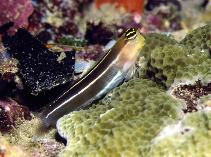| Family: |
Blenniidae (Combtooth blennies), subfamily: Salariinae |
| Max. size: |
3.2 cm SL (male/unsexed); 3.2 cm SL (female) |
| Environment: |
reef-associated; marine; depth range 0 - 8 m |
| Distribution: |
Western Central Pacific: known only from Goodenough Island, D'Entrecasteaux Islands, and nearby Basilaki Island (Papua New Guinea). |
| Diagnosis: |
Dorsal spines (total): 12-12; Dorsal soft rays (total): 14-14; Anal spines: 2-2; Anal soft rays: 16-16; Vertebrae: 32-33. Description: Dorsal fin XII, 14, with deep notch between spinous and ray portions; anal fin II,15-17; pectoral rays 13; pelvic fin I, 3; caudal-fin segmented rays 13. Body depth 4.5-4.8 in SL at anal-fin origin. Vertebrae 10 + 22-23; incisors and anterior canine teeth look very similar, 44,46, and 47 in total; posterior canines 1 on each side, sometimes absent. Lateral line without pores, ends below dorsal spine 8-10. Anterior nostril with cirrus present only on posterior rim. Overall brown, anteriorly yellowish, dorsal side with two narrow pale stripes widely spaced. Eyes with narrow yellow ring around the pupil and yellow streaks on iris. Mid-postorbital margin with prominent dark spot. Pale stripe from eyes to posterior edge of operculum continuous with the ventral pale stripe on body. Dorsal-fin ray portion with suprabasal stripe, thin and dusky (Ref. 5296, 90102). |
| Biology: |
Adults occur solitary or in small groups on sponges and corals (Ref. 90102). Oviparous. Eggs are demersal and adhesive (Ref. 205), and are attached to the substrate via a filamentous, adhesive pad or pedestal (Ref. 94114). Larvae are planktonic, often found in shallow, coastal waters (Ref. 94114). |
| IUCN Red List Status: |
Least Concern (LC); Date assessed: 25 March 2009 Ref. (130435)
|
| Threat to humans: |
harmless |
Source and more info: www.fishbase.org. For personal, classroom, and other internal use only. Not for publication.

